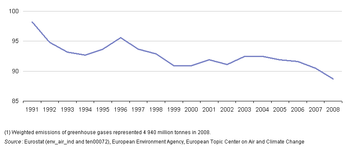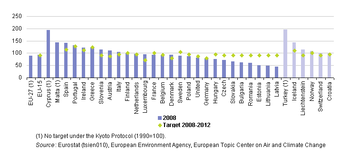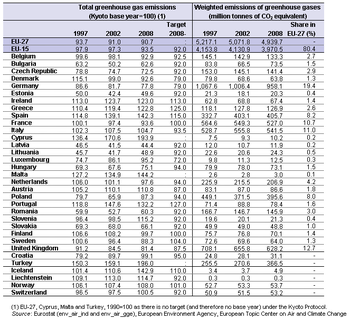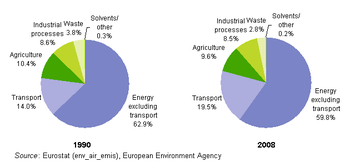This text is in the process of being harmonised for use in the 2011 edition of the Eurostat Yearbook - the Excel content is being standardised to publication standards and the text is being reviewed. This work is scheduled to be complete for all articles by 26 NOVEMBER 2010. During this period (when all content for the 2011 edition is due to be finalised) please do not make any further edits to this article. Once finalised, authors will once again be able to revise and update their articles.
- Data from September 2010, most recent data: Further Eurostat information, Tables and Database.
This article presents statistical data on man-made emissions of the main greenhouse gases: carbon dioxide (CO2), methane (CH4), nitrous oxide (N2O),hydrofluorocarbons (HFCs), perfluorocarbons (PFCs) and sulphur hexafluoride (SF6). All were converted to CO2-equivalents in order to make them comparable.
This article focuses only on the direct pressures that drive climate change (namely, greenhouse gases) and does not discuss other statistical information related to the driving forces behind those pressures (e.g. energy, transport, etc.), nor the impacts of climate change on human development (e.g. on health, agriculture, etc.).
Greenhouse gas emissions in the EU stood at 4 940 million tonnes of CO2 equivalents in 2008. This figure marked an overall reduction of 11.3 % when compared with 1990, or some 627 million tonnes of CO2 equivalents. There was generally a downward trend to emissions during the period 1990 to 1997 (aside from a relative peak in 1996, when a cold winter led to an increase in heating requirements). Since 1998, the evolution of greenhouse gas emissions within the EU-27 has remained relatively unchanged. According to the Climate action and renewable energy package adopted in 2008, the EU is committed to reducing its overall emissions to at least 20 % below 1990 levels by 2020, in line with the ambition to transform Europe into a low-carbon economy while increasing its energy security.
Main statistical findings
Greenhouse gas emissions in the EU-27 stood at 4 940 million tonnes
of CO2 equivalents in 2008. This figure marked an overall reduction of 11.3 % when compared with 1990, or some 627 million tonnes of CO2 equivalents. There was generally a downward trend to emissions during the period 1990 to 1997 (aside from a relative peak in 1996, when a cold winter led to an increase in heating requirements). Since 1998, the evolution of greenhouse gas emissions within the EU-27 has remained relatively unchanged. Carbon dioxide accounted for 82.8 % of EU greenhouse gas emissions in 2008, followed by methane (8.3 %), nitrous oxide (7.3 %) and fluorinated gases (1.7 %). Fluorinated gases were the only group to record an overall increase in their amount of emissions between 1990 and 2008 (up 40.3 %); this may be entirely attributed to hydrofluorocarbons (HFCs), which have, in recent years, been increasingly used as substitutes for ozone-depleting compounds such as chlorofluorocarbons (CFCs) in refrigeration, air conditioning, or the manufacture of insulating foams.
Across the Member States, greenhouse gas emissions were highest in Germany (19.4 % of the EU total or 958 million tonnes of CO2 equivalents in 2008), while the United Kingdom (12.7 %), Italy (11.0 %) and France (10.7 %) were the only other countries to record double-digit shares. EU-15 Member States accounted for 80.4 % of total greenhouse gas emissions within the EU-27 in 2008, some 4.1 percentage points above their corresponding share of 1990. The ‘burden-sharing agreement’ between EU-15 Member States foresees that four countries (Ireland, Spain, Greece and Portugal) may increase their emission levels through to the first commitment period (2008-2012). Some of the biggest overall increases in greenhouse gas emissions between 1990 and 2007 were recorded on the Iberian Peninsula, with gains of 43.3 % and 32.2 % in Spain and Portugal; Cyprus and Malta also recorded significant increases in their emission levels (although they are not parties to the Kyoto Protocol).
By far the most important source of greenhouse gas emissions across the EU was energy including the energy transformation sector (in particular, oil and gas-fired power stations), transport and fuel combustion in industry. This category was consistently the principal source of emissions throughout the period 1990 to 2008; the latest data available shows energy (excluding transport) with a 59.8 % share of total emissions (or more than 3 000 million tonnes of CO2 equivalents).
The transport sector (a subsector of the IPCC energy sector) was the next largest contributor (19.5 % of the EU’s greenhouse gas emissions in 2008), and was also the IPCC sector (see #Data_sources_and_availability) where emissions were increasing at their fastest pace – within the confines of Kyoto reporting (road freight and passenger cars).
Agriculture accounted for 9.6 % of all greenhouse gas emissions in the EU in 2008; contrary to other areas, where carbon dioxide was the principal greenhouse gas emitted, agricultural emissions are largely composed of nitrous oxide and methane. Emissions from industrial processes, solvents and product use accounted for a slightly lower share (8.5 %), while emissions from waste (which includes disposal, landfill sites and water treatment) accounted for the remaining 2.8 % of the EU’s greenhouse gas emissions in 2008.
Data sources and availability
Data on greenhouse gas emissions are officially reported under the United Nations Framework Convention on Climate Change (UNFCCC). The Kyoto Protocol covers legally binding commitments in relation to the reduction of the following six types of greenhouse gases: carbon dioxide (CO2); methane (CH4); nitrous oxide (N2O); sulphur hexafluoride (SF6); hydrofluorocarbons (HFCs), and perfluorocarbons (PFCs). Note that while chlorofluorocarbons (CFCs) and hydrochlorofluorocarbons (HCFCs) are greenhouse gases, they are not included in the Kyoto Protocol (as they were previously covered by the Montreal Protocol on substances that deplete the ozone layer).
Each greenhouse gas has a different capacity to cause global warming, depending on its radiative properties, molecular weight and the length of time it remains in the atmosphere. The global warming potential (GWP) of each gas is defined in relation to a given weight of carbon dioxide for a set time period (for the purpose of the Kyoto Protocol a period of 100 years). GWPs are used to convert emissions of greenhouse gases to a relative measure (known as carbon dioxide equivalents: CO2 equivalents), the following weighting factors are currently used: carbon dioxide = 1, methane = 21, nitrous oxide = 310, and sulphur hexafluoride = 23 900; hydrofluorocarbons and perfluorocarbons comprise a large number of different gases that have different GWPs.
The European Environment Agency compiles an annual European Community greenhouse gas inventory report for submission to the UN. Within the inventory reporting requirements of Kyoto, estimates of greenhouse gas emissions are produced for a number of IPCC defined sectors which are delineated primarily according to process-technologies. The five main Intergovernmental Panel on Climate Change (IPCC) sectors include:
- energy (fuel combustion);
- industrial processes;
- solvent and other product use;
- agriculture;
- waste.
Note that the use of fuel in ships or aircraft engaged in international transport is excluded from the reporting mechanism. Information pertaining to land use changes and forestry are also reported but the view taken in this publication focuses only on the (gross) emissions rather than the emissions and the removals or sinks (net emissions).
Context
The term ‘climate’ covers meteorological phenomena over a lengthy period of time, for example, trends in temperature, storm activity or rainfall. Climate change results from natural phenomena and has occurred periodically throughout history – sometimes with catastrophic effects, such as the extinction of various species during the different ice ages. Over the past two decades a growing body of scientific evidence has been established that suggests that the most recent changes in the earth’s climate have been substantially influenced by human activity, so-called anthropogenic effects.
Solar energy (heat from the sun), arrives in the earth’s atmosphere as short wavelength radiation. Some of this is reflected by the earth’s surface (especially from snow and ice covered areas) and atmosphere; however, the vast majority is absorbed, warming the planet. As the earth’s surface gains heat, it starts to emit long wavelength, infra-red radiation back into the atmosphere. Despite their relative scarcity (less than 0.1 % of the total atmosphere, which consists mostly of nitrogen and oxygen), greenhouse gases are vital to life on earth because of their ability to act like a blanket, trapping some of this infra-red radiation and preventing it from escaping back into space; without this process the temperature on the earth’s surface would be a lot colder. This layer of greenhouse gases has become thicker as a result of human activity and this process would appear to be disturbing the natural balance between incoming and outgoing radiative energy.
Substantial amounts of human-induced greenhouse gas emissions have come from the increased use of fossil fuels burned to power new machines, generate electricity and propel vehicles in transport. The amount of emissions has accelerated in the last 200 years, reflecting increases in the world’s population, economic development, and increased production and consumption in a globalised economy.
The Kyoto Protocol is an international agreement that committed industrialised nations to reduce or at least limit the growth of their greenhouse gas emissions. The protocol was agreed on in 1997, setting legally-binding targets with the goal to reduce greenhouse gas emissions in developed countries by 2008-2012. However, it was not until 18 November 2004 when the Russian Federation ratified the protocol that the prescribed conditions were met and the Kyoto Protocol entered into force on 16 February 2005.
Kyoto established different commitments for each country according to their share of global greenhouse gas emissions and economic development. Globally, developed countries were required to reduce their collective emissions from 1990 base year levels by at least 5 % during the first commitment period (average emission levels for the period 2008-2012). Political negotiation and compromise resulted in different national targets: hence, while cuts of 8 % (relative to 1990 levels) were agreed for the EU-15, Switzerland and many central and eastern European countries, a number of other countries only agreed to stabilise their emission levels (New Zealand and Russia), while some countries were allowed to increase emissions (Australia and Iceland by 8 % and 10 % respectively).
The European Union agreed to an 8 % reduction in its greenhouse gas emissions for the EU-15 by 2008-2012. The reductions for each of the EU-15 Member States were agreed under the so-called ‘burden sharing agreement’, which allowed some countries to increase emissions, provided these were offset by reductions in others. Among the EU-15 Member States these range from decreases of 28 % for Luxembourg and 21 % for Denmark and Germany, to increases of 25 % and 27 % for Greece and for Portugal. Of the 12 Member States that have joined the EU since 2004, Cyprus and Malta are not parties to the Kyoto Protocol, while the remaining ten countries have their own individual reduction targets, generally set at 8 %, although for Hungary and Poland the target is 6 %, and there are also base years other than 1990.
In an attempt to find alternative ways to reduce emissions, three market-based mechanisms were introduced to help countries meet their Kyoto commitments:
- joint implementation (JI);
- the clean development mechanism (CDM), and;
- international emissions trading (IET).
These initiatives seek to aid those countries for which it may be easier and/or more cost-effective to enhance carbon sinks or cut emissions abroad – rather than on their national territory, based upon the premise that the overall effect of such actions (for the atmosphere) is the same regardless of where (geographically) the action is taken. Emissions trading schemes enable developed countries to acquire assigned amount units (AAUs) from other developed countries that are more able to reduce their emissions. This form of trading allows countries that have achieved emission reductions beyond those required by the Kyoto Protocol to sell their excess reductions to other countries that are finding it more difficult or expensive to meet their commitments.
One cornerstone of the EU’s climate change strategy is the Emissions trading system (ETS). The scheme covers about 12 000 factories and plants that together are responsible for about half of the EU’s greenhouse gas emissions. Under the system, governments set limits on the amount of carbon dioxide and other greenhouse gases to be emitted by energy-intensive industries (such as utilities and steel producers) or other industries with high levels of greenhouse gas emissions arising from their production systems such as the cement industry. If these enterprises need to emit more greenhouse gases than their permits allow, they have to buy spare permits from the marketplace.
A revised Directive (2009/29/EC)to improve and extend the greenhouse gas emission allowance trading scheme of the Union was adopted on 6 April 2009. This is designed to achieve greater emissions reductions in energy-intensive sectors from the start of a third ETS period as of 1 January 2013. To stimulate the adoption of clean technologies, the new ETS provides that emissions permits will no longer be given to industry for free, but instead they will be auctioned. Each Member State will determine the use of its revenues from auctioning pollution permits (although at least half of the proceeds should be used to fight climate change in the EU and abroad and to alleviate the social consequences of moving towards a low-carbon economy).
Further Eurostat information
Publications
- Energy, transport and environment indicators (Pocketbook)
- Using official statistics to calculate greenhouse gas emissions - A statistical Guide
Tables
- Environment (t_env), see:
Greenhouse gas emissions, Kyoto base year
Urban population exposure to air pollution by particulate matter
Urban population exposure to air pollution by ozone
Weighted emissions of greenhouse gases
Greenhouse gas emissions by sector
Greenhouse gas emissions from transport
Database
- Environment (env), see:
Greenhouse Gases/Air Pollution
Greenhouse Gas Emissions (source: EEA)
Methodology/Metadata
- Greenhouse Gas Emissions (source: EEA) [ESMS metadata file - env_air_gge_esms]
Other information
- Communication COM(2005)35 ’Winning the Battle Against Global Climate Change’
Source data for tables, figures and maps on this page (MS Excel)
External links
- European Commission - Environment - Climate Change
- European Commission - Environment - Emission Trading System (EU ETS)
- IPCC - Intergovernmental Panel on Climate Change
- United Nations Framework Convention on Climate Change (UNFCCC)




